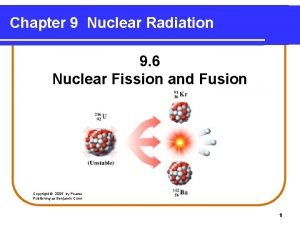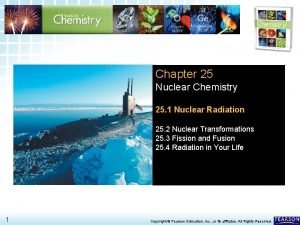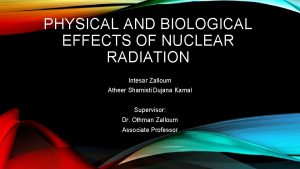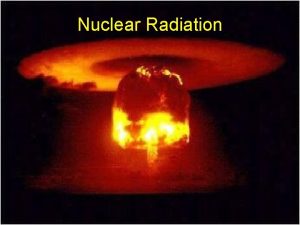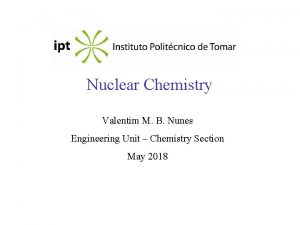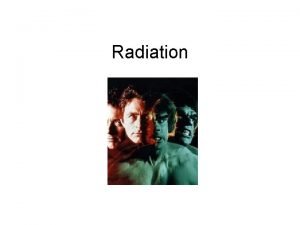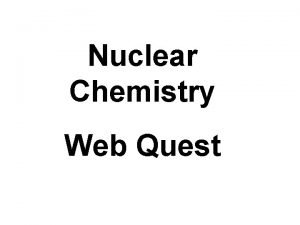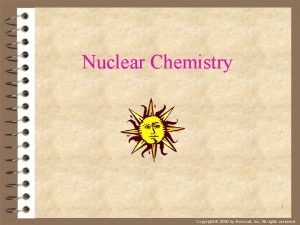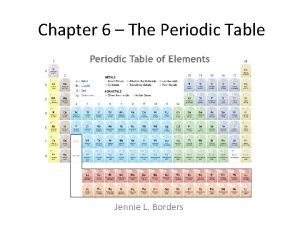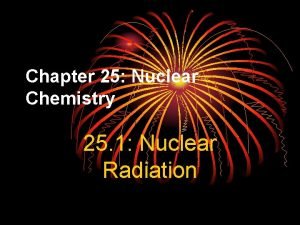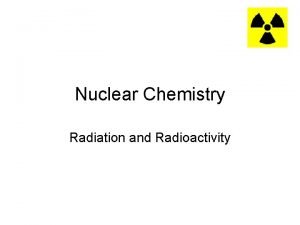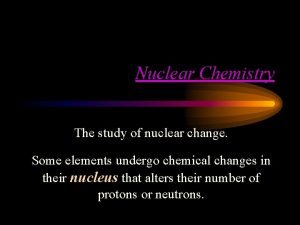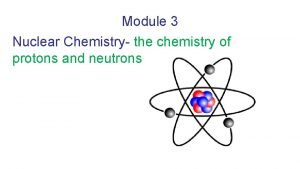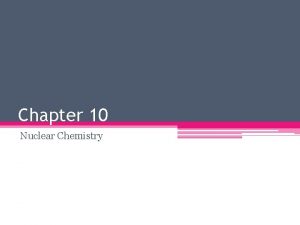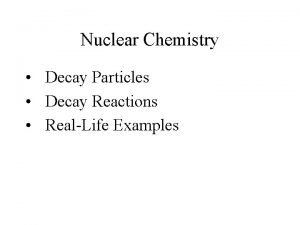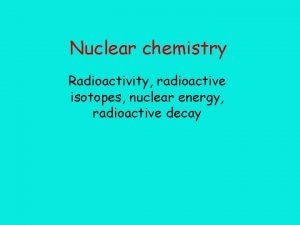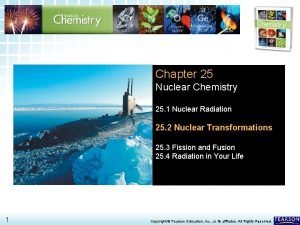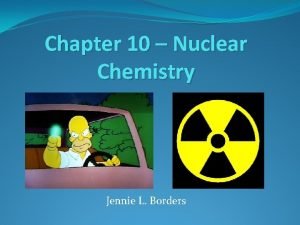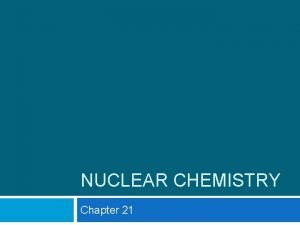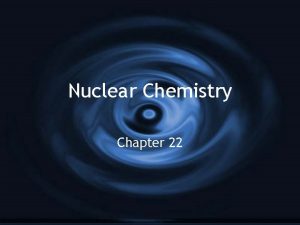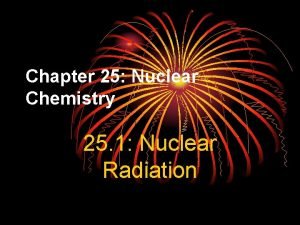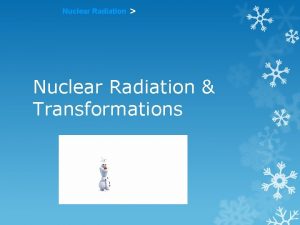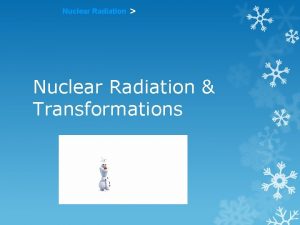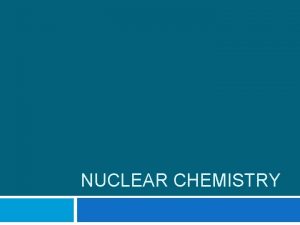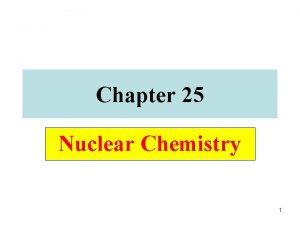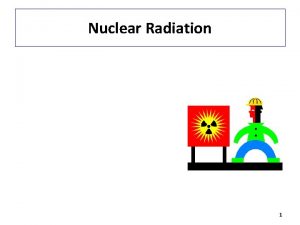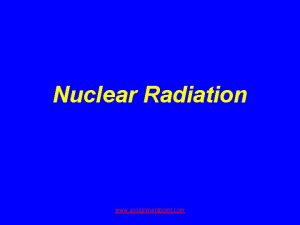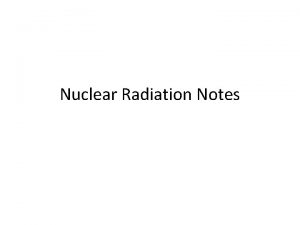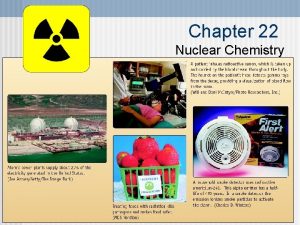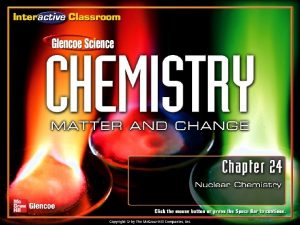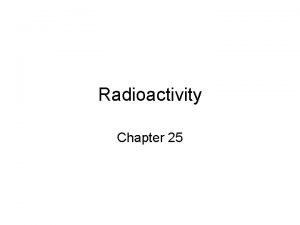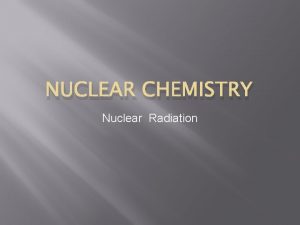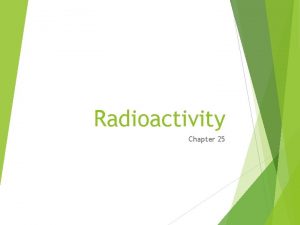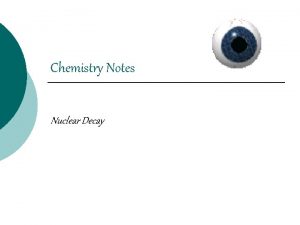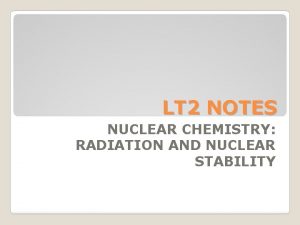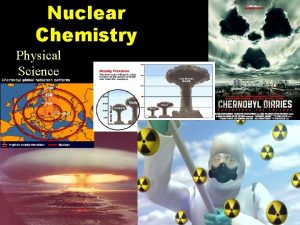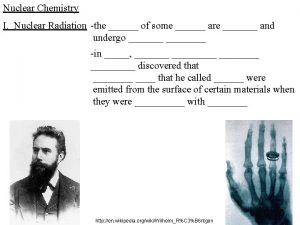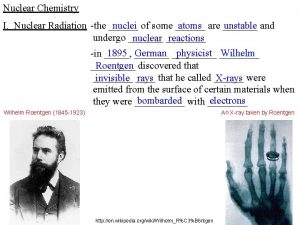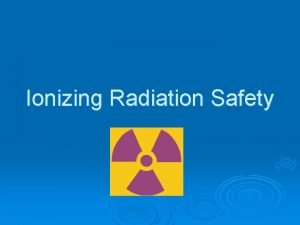Nuclear Chemistry 25 1 Nuclear Radiation Chemistry I

























- Slides: 25

Nuclear Chemistry


25. 1 Nuclear Radiation Chemistry I Mrs. Ragsdale

Nuclear Radiation Certain materials are considered “radioactive” because they give off penetrating rays and particles Nuclear radiation = penetrating rays emitted by nuclear reactions

Chemical vs Nuclear Reactions Chemical Reactions atoms gain, lose or share electrons in order to become stable Chemical Reactions Nuclear reactions – the nuclei of unstable isotopes (called radioisotopes) become stable by emitting large amounts of energy. This allows them to undergo changes and become stable. Unaffected by catalysts, changes in temperature, or pressure Nuclear Reactions

3 Main Types of Radiation Alpha (α) Beta (β) Gamma (γ)

Alpha Radiation α When a radioactive source emits a helium atom ◦ Consists of two protons and two neutrons ◦ Has a double positive charge Uranium - 238 ◦ ◦ 238 = 146 neutrons : 92 protons After alpha decay 144 neutrons : 90 protons Becomes Thorium 234

Beta Radiation β Beta radiation occurs when an atom either has too many protons or too many neutrons in is nucleus An electron results from the breaking apart of a neutron in an atom Discovered by Ernest Rutherford (remember the gold foil guy? )

Gamma Radiation High energy photons emitted by radioisotopes Gamma Radiation is usually emitted whenever Alpha or Beta radiation is emitted

Radiation Penetration

Radiation Penetration Gamma radiation penetrates the most through materials Can only be stopped by several feet of lead

Nuclear Decay Radiation – giving off particles and energy Nuclear Decay – when a isotope nucleus “decays” by giving off neutrons ◦ The point of nuclear decay is to return a radioactive isotope to a stable configuration

Band of Stability

Transmutation Converting an atom of one element into an atom of another element. Occurs by radioactive decay!

Half-Life The time required for one-half of the nuclei of a radioisotope sample to decay to products

Calculating Half-Lives Manganese-56 is a beta emitter with a half life of 2. 6 h. What is the mass of manganese -56 in a 1. 0 mg sample of the isotope at the end of 10. 4 h?

Calculating Half-Lives A sample of thorium-234 has a half life of 25 days. What portion of a 50 g sample will remain after 100 days?

25. 3 Fission and Fusion of Atomic Nuclei Chemistry I Mrs. Ragsdale

Nuclear Fission • • Splitting a nucleus into smaller fragments by bombarding an isotope with neutrons. This can lead to a chain reaction of neutrons bombarding the nuclei of nearby atoms.

Nuclear Reactors Use controlled fission to produce heat (useful energy) Some form of cooling liquid removes the heat and uses it to create steam The steam turns a turbine to generate electrical energy

Nuclear Waste – The Major Problem with Nuclear Energy Water is used to cool spent rods and act as a radiation shield Once the spent fuel rods are removed from the nuclear reactor, they continue to produce heat for years later Problem! It is cheaper to mine more uranium than to fix and reuse these spent rods ◦ So what do we do? Build up nuclear waste! ◦ Most power plants have been forced to create offsite nuclear waste storage facilities.

Nuclear Fusion Nuclei are combined to form a nucleus of greater mass Extremely high energy!!

Fusion Reactors – Energy of the Future? Major Advantages ◦ Able to use abundant sources of fuel ◦ Will NOT leak dangerous radiation ◦ Produce SIGNIFICANTLY less radioactive waste Reactors are in the experimental phase around the world


Taylor Wilson 14 year old creates a nuclear fusion reactor…. in his parent’s garage! http: //www. ted. com/talks/taylor_wilson_yup _i_built_a_nuclear_fusion_reactor
 Nuclear fusion radiation
Nuclear fusion radiation 25.1 nuclear radiation
25.1 nuclear radiation What is nuclear radiation
What is nuclear radiation Nuclear radiation
Nuclear radiation Lesson 15 nuclear quest nuclear reactions
Lesson 15 nuclear quest nuclear reactions Fisión nuclear vs fision nuclear
Fisión nuclear vs fision nuclear Alpha beta gamma
Alpha beta gamma Applications of nuclear chemistry
Applications of nuclear chemistry Nuclear chemistry review worksheet answer key
Nuclear chemistry review worksheet answer key Nuclear chemistry webquest answer key
Nuclear chemistry webquest answer key Copyright
Copyright What is nuclear charge in chemistry
What is nuclear charge in chemistry Chapter 25 nuclear chemistry
Chapter 25 nuclear chemistry T half life formula
T half life formula Nuclear chemistry
Nuclear chemistry Nitrogen-13 decay equation
Nitrogen-13 decay equation Radioactive tracers in agriculture
Radioactive tracers in agriculture Chapter 10 nuclear chemistry
Chapter 10 nuclear chemistry Nuclear fusion in real life
Nuclear fusion in real life Application of nuclear chemistry
Application of nuclear chemistry Irradiated food
Irradiated food Chapter 25 nuclear chemistry answer key
Chapter 25 nuclear chemistry answer key Chapter 10 nuclear chemistry
Chapter 10 nuclear chemistry Chapter 21 review nuclear chemistry
Chapter 21 review nuclear chemistry Application of nuclear chemistry
Application of nuclear chemistry Nuclear fusion
Nuclear fusion
